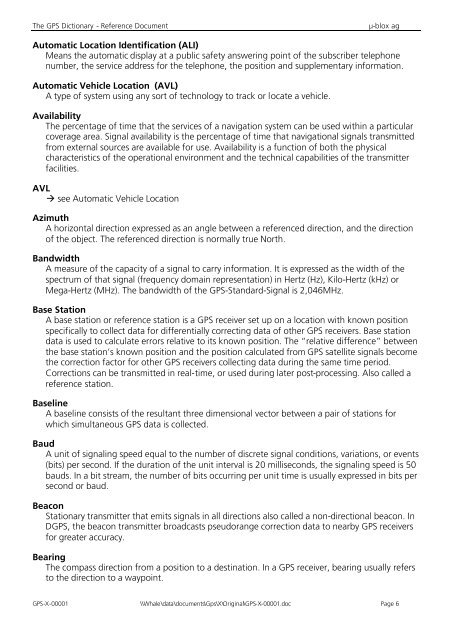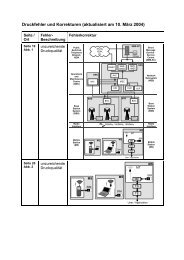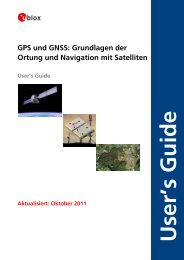The GPS Dictionary - Zogg-jm.ch
The GPS Dictionary - Zogg-jm.ch
The GPS Dictionary - Zogg-jm.ch
- No tags were found...
You also want an ePaper? Increase the reach of your titles
YUMPU automatically turns print PDFs into web optimized ePapers that Google loves.
<strong>The</strong> <strong>GPS</strong> <strong>Dictionary</strong> - Reference Document<br />
µ-blox ag<br />
Automatic Location Identification (ALI)<br />
Means the automatic display at a public safety answering point of the subscriber telephone<br />
number, the service address for the telephone, the position and supplementary information.<br />
Automatic Vehicle Location (AVL)<br />
A type of system using any sort of te<strong>ch</strong>nology to track or locate a vehicle.<br />
Availability<br />
<strong>The</strong> percentage of time that the services of a navigation system can be used within a particular<br />
coverage area. Signal availability is the percentage of time that navigational signals transmitted<br />
from external sources are available for use. Availability is a function of both the physical<br />
<strong>ch</strong>aracteristics of the operational environment and the te<strong>ch</strong>nical capabilities of the transmitter<br />
facilities.<br />
AVL<br />
à see Automatic Vehicle Location<br />
Azimuth<br />
A horizontal direction expressed as an angle between a referenced direction, and the direction<br />
of the object. <strong>The</strong> referenced direction is normally true North.<br />
Bandwidth<br />
A measure of the capacity of a signal to carry information. It is expressed as the width of the<br />
spectrum of that signal (frequency domain representation) in Hertz (Hz), Kilo-Hertz (kHz) or<br />
Mega-Hertz (MHz). <strong>The</strong> bandwidth of the <strong>GPS</strong>-Standard-Signal is 2,046MHz.<br />
Base Station<br />
A base station or reference station is a <strong>GPS</strong> receiver set up on a location with known position<br />
specifically to collect data for differentially correcting data of other <strong>GPS</strong> receivers. Base station<br />
data is used to calculate errors relative to its known position. <strong>The</strong> “relative difference” between<br />
the base station’s known position and the position calculated from <strong>GPS</strong> satellite signals become<br />
the correction factor for other <strong>GPS</strong> receivers collecting data during the same time period.<br />
Corrections can be transmitted in real-time, or used during later post-processing. Also called a<br />
reference station.<br />
Baseline<br />
A baseline consists of the resultant three dimensional vector between a pair of stations for<br />
whi<strong>ch</strong> simultaneous <strong>GPS</strong> data is collected.<br />
Baud<br />
A unit of signaling speed equal to the number of discrete signal conditions, variations, or events<br />
(bits) per second. If the duration of the unit interval is 20 milliseconds, the signaling speed is 50<br />
bauds. In a bit stream, the number of bits occurring per unit time is usually expressed in bits per<br />
second or baud.<br />
Beacon<br />
Stationary transmitter that emits signals in all directions also called a non-directional beacon. In<br />
D<strong>GPS</strong>, the beacon transmitter broadcasts pseudorange correction data to nearby <strong>GPS</strong> receivers<br />
for greater accuracy.<br />
Bearing<br />
<strong>The</strong> compass direction from a position to a destination. In a <strong>GPS</strong> receiver, bearing usually refers<br />
to the direction to a waypoint.<br />
<strong>GPS</strong>-X-00001 \\Whale\data\documents\Gps\X\Original\<strong>GPS</strong>-X-00001.doc Page 6





